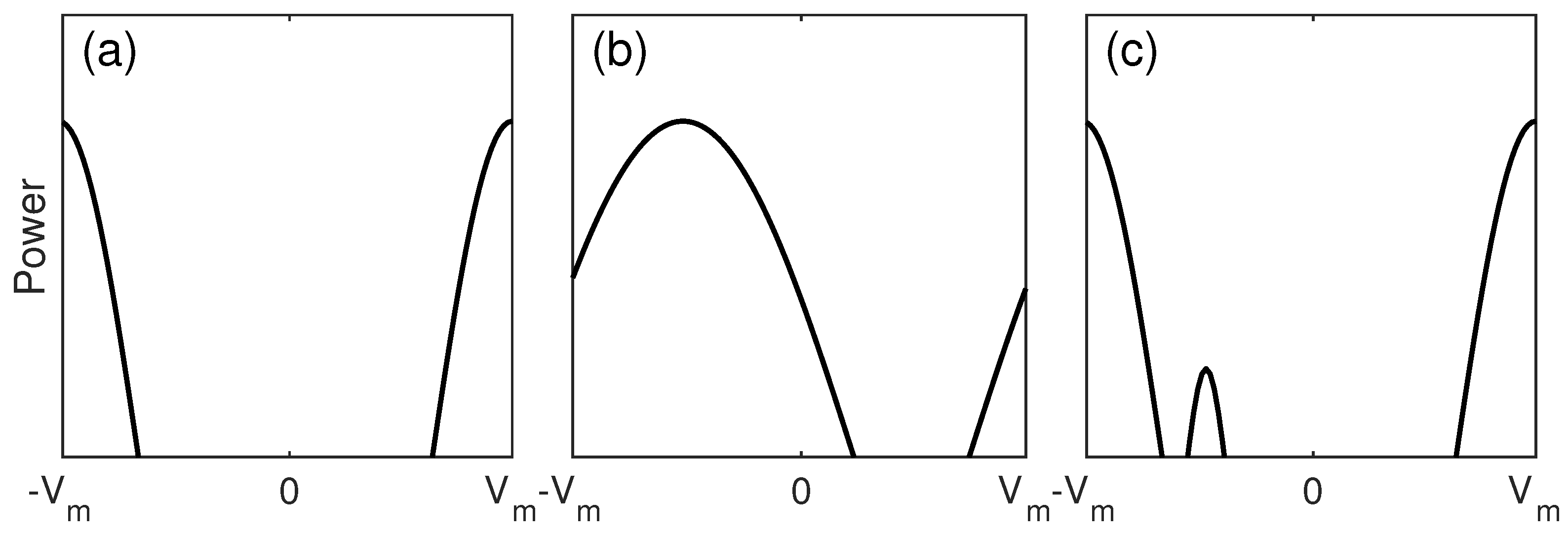A 94 GHz Pulse Doppler Solid-State Millimeter-Wave Cloud Radar
Abstract
:1. Introduction
2. System Design
2.1. Waveform
2.2. Cassegrain Antenna
2.3. Transceiver
3. Signal Processing
3.1. Noise-Level Estimation
3.2. Cloud Signal Detection
3.3. Velocity Dealiasing
4. Data Products
5. Conclusions and Future Work
Author Contributions
Funding
Data Availability Statement
Conflicts of Interest
Appendix A
Appendix A.1. Deviation of the Ratio of the Mean to Standard Deviation of the Mixed Signal
References
- Arking, A. The radiative effects of clouds and their impact on climate. Bull. Am. Meteorol. Soc. 1991, 72, 795–814. [Google Scholar] [CrossRef]
- Ran, Y.; Wang, H.; Tian, L.; Wu, J.; Li, X. Precipitation cloud identification based on faster-RCNN for Doppler weather radar. EURASIP J. Wirel. Commun. Netw. 2021, 2021, 19. [Google Scholar] [CrossRef]
- McGill, M.; Hlavka, D.; Hart, W.; Scott, V.S.; Spinhirne, J.; Schmid, B. Cloud physics lidar: Instrument description and initial measurement results. Appl. Opt. 2002, 41, 3725–3734. [Google Scholar] [CrossRef] [PubMed] [Green Version]
- Lhermitte, R. A 94-GHz Doppler radar for cloud observations. J. Atmos. Ocean. Technol. 1987, 4, 36–48. [Google Scholar] [CrossRef]
- Im, E.; Wu, C.; Durden, S.L. Cloud profiling radar for the CloudSat mission. In Proceedings of the IEEE International Radar Conference, Arlington, VA, USA, 9–12 May 2005; pp. 483–486. [Google Scholar] [CrossRef]
- Chandra, A.; Zhang, C.; Kollias, P.; Matrosov, S.; Szyrmer, W. Automated rain rate estimates using the Ka-band ARM zenith radar (KAZR). Atmos. Meas. Tech. 2015, 8, 3685–3699. [Google Scholar] [CrossRef] [Green Version]
- Takano, T.; Nakanishi, Y.; Takamura, T. High resolution FMCW Doppler radar FALCON-I for W-band meteorological observations. In Proceedings of the 2012 15 International Symposium on Antenna Technology and Applied Electromagnetics, Toulouse, France, 25–28 June 2012; pp. 1–4. [Google Scholar] [CrossRef]
- Huggard, P.; Oldfield, M.; Moyna, B.; Ellison, B.; Matheson, D.; Bennett, A.; Gaffard, C.; Oakley, T.; Nash, J. 94 GHz FMCW cloud radar. In Proceedings of the Millimetre Wave and Terahertz Sensors and Technology, Cardiff, UK, 15–18 September 2008; Volume 7117, pp. 16–21. [Google Scholar] [CrossRef]
- Wu, J.; Wei, M.; Hang, X.; Zhou, J.; Zhang, P.; Li, N. The first observed cloud echoes and microphysical parameter retrievals by China’s 94-GHz cloud radar. J. Meteorol. Res. 2014, 28, 430–443. [Google Scholar] [CrossRef]
- Delanoë, J.; Protat, A.; Vinson, J.P.; Brett, W.; Caudoux, C.; Bertrand, F.; Du Châtelet, J.P.; Hallali, R.; Barthes, L.; Haeffelin, M.; et al. BASTA: A 95-GHz FMCW Doppler radar for cloud and fog studies. J. Atmos. Ocean. Technol. 2016, 33, 1023–1038. [Google Scholar] [CrossRef] [Green Version]
- Montgomery, R.; Courtney, P. Solid-State PAs Battle TWTAs for ECM Systems. Microw. J. 2017. Available online: https://www.microwavejournal.com/articles/28478-solid-state-pas-battle-twtas-for-ecm-systems (accessed on 10 May 2023).
- Wang, J.; Lin, H.; Yang, F.; Xu, G.; Ge, J. Design of 94 GHz Dual-Polarization Antenna Fed by Diagonal Horn for Cloud Radars. IEEE Access 2022, 10, 22480–22486. [Google Scholar] [CrossRef]
- Hildebrand, P.H.; Sekhon, R. Objective determination of the noise level in Doppler spectra. J. Appl. Meteorol. (1962–1982) 1974, 13, 808–811. [Google Scholar] [CrossRef]
- Petitdidier, M.; Sy, A.; Garrouste, A.; Delcourt, J. Statistical characteristics of the noise power spectral density in UHF and VHF wind profilers. Radio Sci. 1997, 32, 1229–1247. [Google Scholar] [CrossRef]
- Shupe, M.D.; Kollias, P.; Matrosov, S.Y.; Schneider, T.L. Deriving mixed-phase cloud properties from Doppler radar spectra. J. Atmos. Ocean. Technol. 2004, 21, 660–670. [Google Scholar] [CrossRef]
- Yuan, Y.; Di, H.; Liu, Y.; Yang, T.; Li, Q.; Yan, Q.; Xin, W.; Li, S.; Hua, D. Detection and analysis of cloud boundary in Xi’an, China, employing 35 GHz cloud radar aided by 1064 nm lidar. Atmos. Meas. Tech. 2022, 15, 4989–5006. [Google Scholar] [CrossRef]
- Maahn, M.; Kollias, P. Improved Micro Rain Radar snow measurements using Doppler spectra post-processing. Atmos. Meas. Tech. 2012, 5, 2661–2673. [Google Scholar] [CrossRef] [Green Version]
- Zheng, J.F.; Liu, L.P.; Zeng, Z.M.; Xie, X.; Wu, J.; Feng, K. Ka-band millimeter wave cloud radar data quality control. J. Infrared Millim. Waves 2016, 35, 748–757. [Google Scholar]
- Joe, P.; May, P. Correction of dual PRF velocity errors for operational Doppler weather radars. J. Atmos. Ocean. Technol. 2003, 20, 429–442. [Google Scholar] [CrossRef]
- Torres, S.M.; Dubel, Y.F.; Zrnić, D.S. Design, implementation, and demonstration of a staggered PRT algorithm for the WSR-88D. J. Atmos. Ocean. Technol. 2004, 21, 1389–1399. [Google Scholar] [CrossRef]












| Frequency | 94 GHz |
| Transmitter type | Solid-state power amplifier |
| Peak transmit power | 6 W |
| Antenna type | Cassegrain antenna |
| Antenna gain | 50.85 dB |
| 3 dB Beamwidth | 0.45° |
| Detection range | 0.3 to 15 km |
| Range resolution | 15 m |
| Pulse length | 1.5/5/20 us |
| Pulse repetition time | 120/150 us |
| FFT numbers | 512 |
| Sensitivity | −30 to 50 dBZ |
Disclaimer/Publisher’s Note: The statements, opinions and data contained in all publications are solely those of the individual author(s) and contributor(s) and not of MDPI and/or the editor(s). MDPI and/or the editor(s) disclaim responsibility for any injury to people or property resulting from any ideas, methods, instructions or products referred to in the content. |
© 2023 by the authors. Licensee MDPI, Basel, Switzerland. This article is an open access article distributed under the terms and conditions of the Creative Commons Attribution (CC BY) license (https://creativecommons.org/licenses/by/4.0/).
Share and Cite
Lin, H.; Wang, J.; Chen, Z.; Ge, J. A 94 GHz Pulse Doppler Solid-State Millimeter-Wave Cloud Radar. Remote Sens. 2023, 15, 3098. https://doi.org/10.3390/rs15123098
Lin H, Wang J, Chen Z, Ge J. A 94 GHz Pulse Doppler Solid-State Millimeter-Wave Cloud Radar. Remote Sensing. 2023; 15(12):3098. https://doi.org/10.3390/rs15123098
Chicago/Turabian StyleLin, Hai, Jie Wang, Zhenhua Chen, and Junxiang Ge. 2023. "A 94 GHz Pulse Doppler Solid-State Millimeter-Wave Cloud Radar" Remote Sensing 15, no. 12: 3098. https://doi.org/10.3390/rs15123098
APA StyleLin, H., Wang, J., Chen, Z., & Ge, J. (2023). A 94 GHz Pulse Doppler Solid-State Millimeter-Wave Cloud Radar. Remote Sensing, 15(12), 3098. https://doi.org/10.3390/rs15123098






